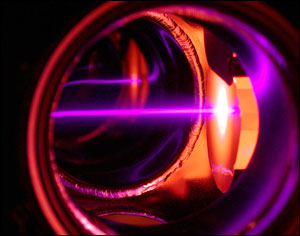GAITHERSBURG, Md., May 8, 2006 -- Physicists at the National Institute of Standards and Technology (NIST) have used lasers to cool and trap erbium atoms, a "rare earth" heavy metal with unusual optical, electronic and magnetic properties. The element has such a complex energy structure that it was previously considered too wild to trap. The demonstration might lead to the development of novel nanoscale devices for telecommunications or quantum computing, or to fine-tuning the properties of semiconductors.
A purple laser beam slows erbium atoms (the purple beam traveling right to left) emerging from an oven at 1300 °C, in preparation for trapping and cooling. The unusual properties of erbium atoms and the new capability to trap them could lead to development of novel technologies. (Photo: NIST)
Laser cooling and trapping involves hitting atoms with laser beams of just the right color and configuration to cause the atoms to absorb and emit light in a way that leads to controlled loss of momentum and heat, ultimately producing a stable, nearly motionless state. Until now, the process has been possible only with atoms that switch easily between two energy levels without any possible stops in between. Erbium has over 110 energy levels between the two used in laser cooling, and thus has many ways to get "lost" in the process. NIST researchers discovered that these lost atoms actually get recycled, so trapping is possible after all.
The NIST team, which reported the findings recently in Physical Review Letters, heated erbium to over 1300 degrees C to make a stream of atoms. Magnetic fields and six counter-propagating purple laser beams were then used to cool and trap over a million atoms in a space about 100 micrometers in diameter. As the atoms spend time in the trap, they fall into one or more of the 110 energy levels, stop responding to the lasers and begin to diffuse out of the trap. Recycling occurs, though, because the atoms are sufficiently magnetic to be held in the vicinity by the trap's magnetic field. Eventually, many of the lurking atoms fall back to the lowest energy level that resonates with the laser light andare recaptured in the trap.
The erbium atoms can be trapped at a density that is high enough to be a good starting point for making a Bose-Einstein condensate, an unusual, very uniform state of matter used in research on quantum computing. Cold-trapped erbium also might be useful for producing single photons, the smallest particles of light, at wavelengths used in telecommunications, NIST said. In addition, trapped erbium atoms might be used for "doping" semiconductors with small amounts of impurities to tailor their properties. Erbium -- which, like other rare earth metals, retains its unique optical characteristics even when mixed with other materials -- is already used in lasers, amplifiers and glazes for glasses and ceramics. Erbium salts, for example, emit pastel pink light.
For more information, visit: www.nist.gov